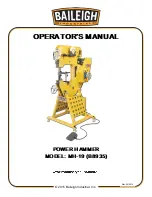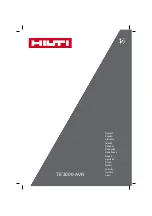
7
Safety
7
CAUTION:
THE RETURN CAPACITY WHEN CHARGING THE BATTERY IS NOT 1-TO-1. ENSURE THAT BATTERY IS ALLOWED TO
CHARGE FOR A GREATER PERIOD OF TIME THAN IT WAS USED (IF NOT COMPLETING A FULL CHARGE). FOR MAXIUMUM BAT-
TERY LIFE, FULLY RECHARGE BATTERY (LED WILL APPEAR SOLID GREEN) AT LEAST TWICE PER WEEK. FAILURE TO DO SO MAY
RESULT IN SHORTER RUNTIMES AND PREMATURE BATTERY FAILURE.
WARNING:
ONLY USE BATTERY/CHARGER CONFIGURATIONS SPECIFICALLY APPROVED BY NFE. USE OF A DIFFERENT OR
INCORRECT CONFIGURATION HAS A HIGH RISK OF LEADING TO FIRE, PREMATURE BATTERY FAILURE, DAMAGE TO MACHINE,
AND/OR BODILY INJURY.
WARNING:
GRINDING/CUTTING/DRILLING OF MASONRY, CONCRETE, METAL AND OTHER MATERIALS CAN GENERATE DUST,
MISTS AND FUMES CONTAINING CHEMICALS KNOWN TO CAUSE SERIOUS FATAL INJURY OR ILLNESS, SUCH AS RESPIRATORY
DISEASE, CANCER, BIRTH DEFECTS OR OTHER REPRODUCTIVE HARM. IF YOU ARE UNFAMILIAR WITH THE RISKS ASSOCIATED
WITH THE PARTICULAR MATERIAL BEING CUT, REVIEW THE MATERIAL SAFETY DATA SHEET AND/OR CONSULT YOU EMPLOYER,
THE MATERIAL MANUFACTURER/SUPPLIER, GOVERNMENTAL AGENCIES SUCH AS OSHA AND NIOSH AND OTHER AUTHORI-
TIES ON HAZARDOUS MATERIALS. CALIFORNIA AND SOME OTHER AUTHORITIES, FOR INSTANCE, HAVE PUBLISHED LISTS OF
SUBSTANCES KNOWN TO CAUSE CANCER, REPRODUCTIVE TOXICITY, OR OTHER HARMFUL EFFECTS. CONTROL DUST, MIST
AND FUMES AT THE SOURCE WHERE POSSIBLE. IN THIS REGARD USE GOOD WORK PRACTICES AND FOLLOW THE RECOM-
MENDATIONS OF THE MANUFACTURER/SUPPLIER, OSHA/NIOSH, AND OCCUPATIONAL AND TRADE ASSOCIATIONS. WHEN THE
HAZARDS FROM INHALATION OF DUST, MISTS AND FUMES CANNOT BE ELIMINATED, THE OPERATOR AND ANY BYSTANDERS
SHOULD ALWAYS WEAR A RESPIRATOR APPROVED BY OSHA/MSHA FOR THE MATERIAL BEING CUT.
Charger Operation
Ensure proper use of charger.
• Once connected and plugged into AC power, the LED will in-
dicate whether or not it is charging. Refer to manufacturer’s
charger manual.
• Only use charger on branch circuits protected by a circuit
breaker or fuse that can carry the power of the charger.
• Do not use charger if it shows signs of physical stress, or if
DC output leads or connector feel hot when used.
• Do not disconnect DC output clamps or connector from bat-
teries while charger is on. This could cause an explosion.
• Failure to unplug AC power before moving equipment will
damage cords, plugs, and receptacles.
• Do not over-discharge batteries, this could cause batteries
to fail. Re-charge as soon as possible after discharge; if they
are warm, first allow them to cool.
• Charger is not water proof, only resistant, and cannot with-
stand immersion, continuous exposure, or heavy rain.
• A drive lockout option will disable the drive mechanism of
the machine while the charger is plugged in.
• There is a built-in Low Voltage Interrupter that continuously
monitors for low voltage and will sound when voltage falls. At
44V the alarm will sound; stop immediately and recharge. At
43.5V the machine will auto-disconnect and shut down; let
machine sit until batteries recover enough to drive to outlet.
• Chargers are equipped with a grounding plug.
Note: Leaving the charger plugged in does not harm the battery
and is preferred to leaving the battery in a state of discharge.
Scraping
Do not drive machine along hills or uneven surfaces.
The weight of the machine may become distributed differently if on
an uneven surface. Too much of an angle could make the machine
unsafe or cause it to tip over. Always keep the front of the machine
facing downward while traveling up or down ramps or inclines. Do
not run the machine in unsafe environments.
Inspect work area for potential hazards prior to operation.
Observe location of electrical supplies and extension cords.
Do not allow cutting heads to come into contact with any electrical
supply or extension cord.
Operator must be seated before starting machine and should
stay seated until motor has stopped running.
This machine is equipped with a safety switch under the seat,
which requires the operator to be seated before the machine can
be operated. Do not attempt the start-up procedure without first
being seated on the machine.
Batteries and Chargers
Use caution; risk of explosive gases.
Batteries generate explosive gases during normal operation. Do
not use near fuels, grain, dust, solvents, or other flammables;
never smoke near the machine, battery, or charger.
Inspect battery and charger regularly.
Disconnect charger from wall outlet before operating. Machine
should be off before connecting to a power source. Periodically
inspect batteries, cables, charger, and all plug connections. Be
extremely cautious when working with batteries. Do not open or
tamper with batteries; doing so could cause electrical shock.
WARNING:
BE CAUTIOUS WHEN WORKING WITH
BATTERY. IF ELECTROLYTIC ACID GETS IN THE EYES,
IMMEDIATELY FLUSH OUT WITH COLD, FRESH WATER
FOR AT LEAST 10 MINUTES AND GET MEDICAL HELP.
RIDE-ON SCRAPER SAFETY GUIDELINES
To
order
go
to
Discount-Equipment.com








































